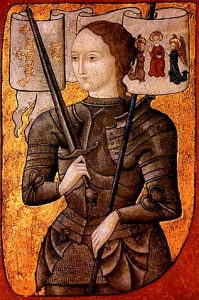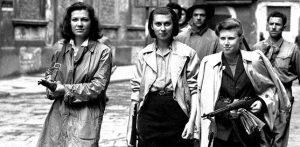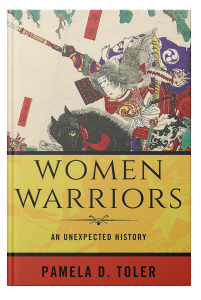Joan of Arc and the French Resistance
More than once in the last few years, I’ve stumbled across stories in old issues of the Chicago Tribune that caught my imagination even though they did not deal with my current project.
In recent weeks, this headline from May 13, 1945, grabbed my attention: “FRANCE HONORS JOAN OF ARC AS ‘FIRST PARTISAN’. “
The piece began “The French paid homage today to their national heroine of five centuries , Joan of Arc, who was hailed as the ‘first of the resisitants’ in military, religious and popular ceremonies.” The article when on to briefly describe the ceremonies and to point out that in prior years it had been French royalists who had celebrated the Maid of Orleans, not French republicans.
It seemed to me that with this recognition, the story of Joan of Arc had come full circle.
Over time, the phrase the “Joan of Arc of [fill in the blank]” has become shorthand for a (usually young) woman leading an army against an occupying foreign power. The term has been applied to the solidly historical Ani Pachen of Tibet and the semi-mythical Trieu Thi Trinh of third century Vietnam. The Women's Era, a popular African American women's newspaper founded in 1890, called Harriet Tubman “the Black Joan of Arc." Novelist Henry Miller heard the story of Greek nationalist Laskarina Bouboulina and asked, "How is it we don't hear more about Bouboulina? ...She sounds like another Joan of Arc." Even at the scale of a besieged city, we find a local heroine described as the “Joan of Arc of Braunschweig.” Each of these women embodied to some degree what Halina Filipowicz describes as the central element of the "Joan of Arc cult": "a deeply felt need for a democratic hero of unflinching loyalty to a patriotic mission."
Joan of Arc had long been the model against which other female resistance fighters where measured. Now it seemed the French government had turned the tables by dubbing Joan of Arc “the first of the resistants” rather than naming a woman resistance fighter “a twentieth century Joan of Arc.”*
*I almost typed “the Joan of Arc of France,” but for that doesn’t work for obvious reasons.
Twice as Hard
Jasmine Brown is a medical student at the University of Pennsylvania. She completed a masters degree in the history of science, medicine and technology at Oxford as a Rhodes Scholar. As an undergraduate, she founded the Minority Association of Rising Scientists (MARS)—a reaction to the realization that though she was the only black student in her lab she was not the only black student at her university.
Brown is also the author of Twice as Hard: The Stories of Black Women Who Fought to Become Physicians, From the Civil War to the 21st Century. In some ways, Twice as Hard is the historical equivalent of MARS. By linking the experience of black women* as medical students and then as doctors across time, she creates a lineage of role models for students like herself. At the same time, she examines the double burdens of systemic sexism and racism through a very specific lens.
In Twice as Hard, Brown tells the stories of nine black women who became physicians in spite of both personal and social obstacles. The first, Dr. Rebecca Lee Crumpler, graduated from medical school in 1864—27 years after the first black man and 15 years after the first white woman obtained their degrees. The last, Dr. Risa Lavizzo-Mourey, is only a few years older than I am—a fact that struck home how far we still have to go in combating systemic racism in our society. Brown details each woman’s challenges and celebrates her accomplishments. (I was particularly taken by the story of Dr. Dorothy Ferebee, who joined forces with other female students in her program across racial and religious divides to confront sexism.) She not only weaves in the historical context for each woman’s story, but compares it to the experiences of black women medical students today.
The end result is a powerful, and often enraging, account of social barriers and women who surmounted them—and a reminder that barriers still remain.
*Brown uses black with a lower case and African American interchangeably throughout the book to describe the women she writes about.
From the Archives: The Ballet that Caused a Riot
This weekend I walked away from desk--deadline or no deadline--to go the ballet. The Joffrey Ballet performed The Little Mermaid--a version that had nothing to do with Disney and everything to do with Hans Christian Anderson. The performance was dark, brilliant, and demanding. We came away exhausted. Now I'm back at work at The Book, which is also demanding. May 1st is just a few days away. (Wish me luck!)
In the meantime, here's a post from 2013 about another ballet that was dark, brilliant and demanding.
 On May 29, 1913, an excited audience, fashionably dressed according to poet and filmmaker Jean Cocteau* in "tails and tulle, diamonds and ospreys,"** waited for the curtain to rise at the Theatre des Champs-Elysées. Serge Diaghilev's Ballet Russe was premiering a new ballet with choreography by Nijinsky and music by Igor Stravinsky-- The Rite of Spring.
On May 29, 1913, an excited audience, fashionably dressed according to poet and filmmaker Jean Cocteau* in "tails and tulle, diamonds and ospreys,"** waited for the curtain to rise at the Theatre des Champs-Elysées. Serge Diaghilev's Ballet Russe was premiering a new ballet with choreography by Nijinsky and music by Igor Stravinsky-- The Rite of Spring.
The Ballet Russe was a breeding ground of early twentieth century modernism.*** Diaghilev produced work that was innovative, exciting, challenging. The music for Stravinsky's two previous ballets, The Firebird and Petrouchka had been agreeably avant-garde, just enough to make the fashionable crowds who attended the ballet feel proud of their sophistication but not enough to be unenjoyable.
The Rite of Spring, subtitled Scenes of Pagan Russia, was a different pair of toe-shoes. When the curtain opened, the audience saw the dancers sitting in two circles in a wasteland scene dominated by massive stones. When the music began, the dancers moved: knees bent, toes turned in, stamping and stomping in a dance style that was the antithesis of classical ballet. The music and dance alike were dissonant, brutal, and self-consciously primitive, telling the "story" of a pagan rite in which a chosen victim dances herself to death as a sacrifice for the spring will come.
The fashionable audience hissed and booed, primitive in their own way. Soon the noise from the audience drowned out the orchestra. The dancers couldn't hear the music on stage; Nijinsky shouted out the count from the wings to help them keep time. Artist Valentine Gross, whose sketches of the Ballet Russe were on display in the lobby, later wrote, "The theatre seemed to be shaken by an earthquake. It seemed to shudder. People shouted insults, howled and whistled…There was slapping and even punching."
Maybe not a riot by soccer standards, but pretty shocking for a night at the ballet.
* Best known today for the film Beauty and the Beast (1946).
**Large artificial plumes, not large fish-eating birds of prey.
***Over the course of his career, Diaghilev would commission librettos by Cocteau, sets by Picasso, Braque, and Matisse, and music by Ravel, Satie, and Stravinsky.









